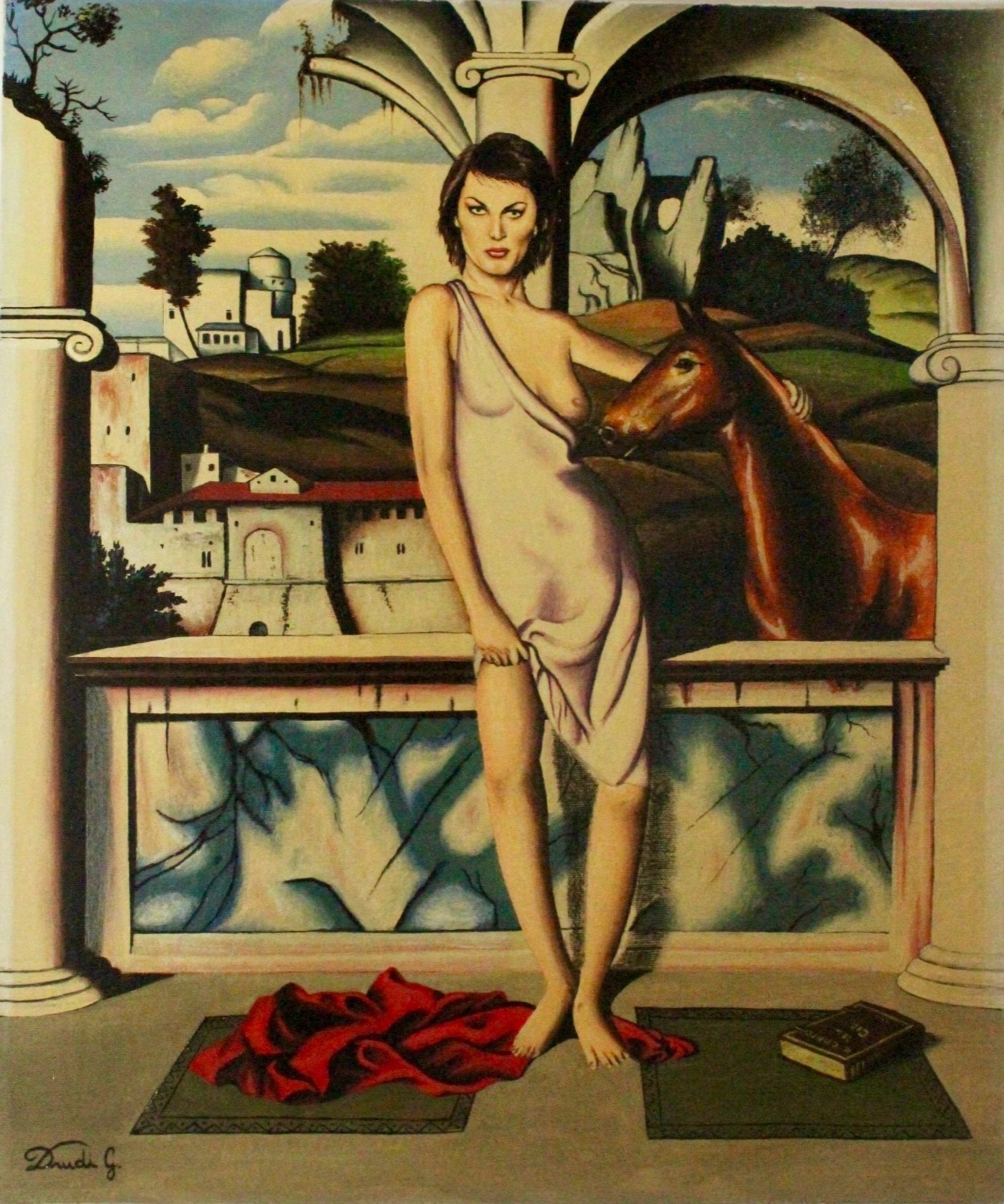LADY XIMENA AT THE COLUMN
1978, 50x60cm, Glossy oil on canvas

Lady XIMENA, wife of El Cid, was the consort of Valencia from 1093 to 1099 and Lady of Valencia from 1099 to 1102. Here portrayed near a column and her horse. Ancient and tranquil landscapes in the background crown her.
The work “Lady Ximena at the Column,” created in 1978 with glossy oil on canvas, is a painting that blends historical, architectural, and symbolic elements in a scene of great visual impact. The artist depicts Lady Ximena, wife of the famous leader El Cid, in an elegant and self-confident pose, while naturally leaning against her horse, a symbol of strength and nobility.
Composition and symbolism:
The painting is dominated by the figure of Lady Ximena, wrapped in a light transparent drape that reveals the shapes of her body, suggesting grace and sensuality. Her penetrating gaze and proud bearing evoke the strong character of the woman, who was not only El Cid’s consort but also the Lady of Valencia between 1099 and 1102, governing with determination after her husband’s death.
To her right, the horse, with which she seems to have an almost spiritual bond, represents pride and loyalty, qualities that Ximena embodies in her life and in her role as a ruler.
The landscape in the background is rich in medieval elements: fortified castles, towers, and gently undulating hills convey a feeling of stability and tranquility. The clear sky and lush vegetation frame this scene, accentuating the almost dreamlike atmosphere of the work.
Details and atmosphere:
The architecture with arches and columns introduces a classical element, giving depth and a sense of historical solemnity to the composition. At the protagonist’s feet, a red garment abandoned on the ground and a closed book suggest an implicit narrative: perhaps a moment of reflection, a love story, a memory of past epochs. The contrast between the intense red of the fabric and the softer tones of the landscape guides the observer’s gaze through the scene, creating a harmonious balance between sensuality, strength, and melancholy.
Conclusion:
With this work, the artist does not limit himself to depicting a historical character but manages to convey the personality and complexity of Lady Ximena: a strong, independent woman bound to her destiny. The painting thus becomes a tribute to femininity and resilience, framed in a landscape that recalls the past with charm and mystery.

Lady XIMENA, wife of El Cid, was the consort of Valencia from 1093 to 1099 and Lady of Valencia from 1099 to 1102. Here portrayed near a column and her horse. Ancient and tranquil landscapes in the background crown her.
The work “Lady Ximena at the Column,” created in 1978 with glossy oil on canvas, is a painting that blends historical, architectural, and symbolic elements in a scene of great visual impact. The artist depicts Lady Ximena, wife of the famous leader El Cid, in an elegant and self-confident pose, while naturally leaning against her horse, a symbol of strength and nobility.
Composition and symbolism:
The painting is dominated by the figure of Lady Ximena, wrapped in a light transparent drape that reveals the shapes of her body, suggesting grace and sensuality. Her penetrating gaze and proud bearing evoke the strong character of the woman, who was not only El Cid’s consort but also the Lady of Valencia between 1099 and 1102, governing with determination after her husband’s death.
To her right, the horse, with which she seems to have an almost spiritual bond, represents pride and loyalty, qualities that Ximena embodies in her life and in her role as a ruler.
The landscape in the background is rich in medieval elements: fortified castles, towers, and gently undulating hills convey a feeling of stability and tranquility. The clear sky and lush vegetation frame this scene, accentuating the almost dreamlike atmosphere of the work.
Details and atmosphere:
The architecture with arches and columns introduces a classical element, giving depth and a sense of historical solemnity to the composition. At the protagonist’s feet, a red garment abandoned on the ground and a closed book suggest an implicit narrative: perhaps a moment of reflection, a love story, a memory of past epochs. The contrast between the intense red of the fabric and the softer tones of the landscape guides the observer’s gaze through the scene, creating a harmonious balance between sensuality, strength, and melancholy.
Conclusion:
With this work, the artist does not limit himself to depicting a historical character but manages to convey the personality and complexity of Lady Ximena: a strong, independent woman bound to her destiny. The painting thus becomes a tribute to femininity and resilience, framed in a landscape that recalls the past with charm and mystery.